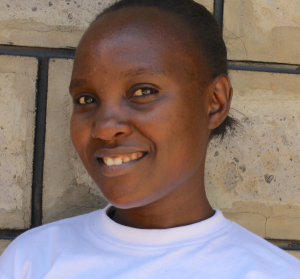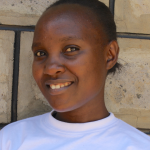Since Ivumbu Primary School didn't have a water source on school grounds, the county donated a 5,000-liter plastic tank. This is a very small amount of water for 237 students, 12 teachers, and one support staff. The water is reserved for drinking and is strictly rationed. In fact, the tap is only unlocked during lunchtime.
Students get very thirsty throughout the day, so they opt to drink water from a river across the street. This river is depended upon by not only the school but the surrounding community as well. This river is large and dangerous for these small students, not to mention the high contamination of the water. Livestock is even brought to drink directly from the water!
Students not only go to get this river water for drinking, but they get it for cleaning their classrooms and latrines as well. The walk to the river is dangerous because the road is very busy, but also tiring as students carry heavy containers of water.
"I carry my drinking water from home but I'm very worried for my pupils. I have been in this school for just six months and I have witnessed so many sick cases," said Headteacher Lwova.
"I just want my pupils to stay in school and excel."
There is a lot of absenteeism from class as students leave early because of stomachaches. When the students come back to school with the doctor's report, they always show that they had been treated for typhoid or amoeba.
What we can do:
Training
Training on good hygiene habits will be held for two days. The facilitator will use PHAST (participatory hygiene and sanitation transformation), ABCD (asset-based community development), CTC (child to child), lectures, group discussions, and handouts to teach health topics and ways to promote good practices within the school. The CTC method will prepare students to lead other students into healthy habits, as well as kickstart a CTC club for the school.
Handwashing Stations
We will deliver two handwashing stations to the school, and the club will fill them with water on a daily basis and make sure there is always a cleaning agent such as soap or ash.
VIP Latrines
The current latrines are in very bad condition. The girls' latrines were recently closed off because they are too dangerous, and the boys' latrines are so old that the headteacher would like to close those off and provide new ones as soon as possible.
Two triple-door latrines will be constructed with local materials that the school will help gather. Three doors will serve the girls while the other three serve the boys. And with a new source of water on school grounds, students and staff should have enough to keep these new latrines clean.
Rainwater Catchment Tank
A 50,000-liter rainwater catchment tank will help alleviate the water crisis at this school. The school will also help gather the needed materials such as sand, rocks, and water for mixing cement. Once finished, this tank can begin catching rainfall that will be used by the school’s students and staff.
We and the school strongly believe that with this assistance, standards will significantly improve. These higher standards will translate to better academic performance!

 Rainwater Catchment
Rainwater Catchment
 Rehabilitation Project
Rehabilitation Project































